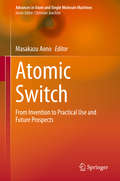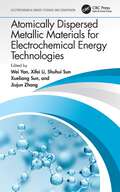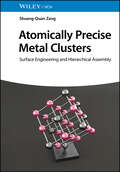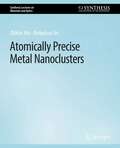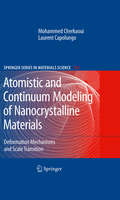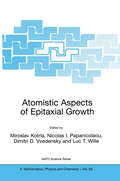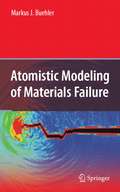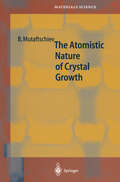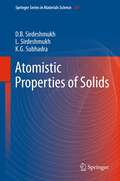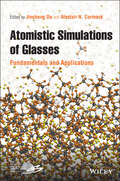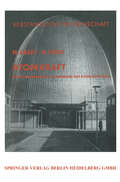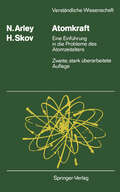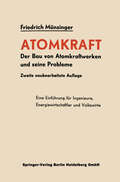- Table View
- List View
Atomic Structure Prediction of Nanostructures, Clusters and Surfaces
by Cristian V. Ciobanu Cai-Zhuan Wang Kai-Ming HoThis work fills the gap for a comprehensive reference conveying the developments in global optimization of atomic structures using genetic algorithms. Over the last few decades, such algorithms based on mimicking the processes of natural evolution have made their way from computer science disciplines to solid states physics and chemistry, where they have demonstrated their versatility and predictive power for many materials. Following an introduction and historical perspective, the text moves on to provide an in-depth description of the algorithm before describing its applications to crystal structure prediction, atomic clusters, surface and interface reconstructions, and quasi one-dimensional nanostructures. The final chapters provide a brief account of other methods for atomic structure optimization and perspectives on the future of the field.
Atomic Switch: From Invention to Practical Use and Future Prospects (Advances in Atom and Single Molecule Machines)
by Masakazu AonoWritten by the inventors and leading experts of this new field, the book results from the International Symposium on “Atomic Switch: Invention, Practical use and Future Prospects” which took place in Tsukuba, Japan on March 27th - 28th, 2017. The book chapters cover the different trends from the science and technology of atomic switches to their applications like brain-type information processing, artificial intelligence (AI) and completely novel functional electronic nanodevices. The current practical uses of the atomic switch are also described. As compared with the conventional semiconductor transistor switch, the atomic switch is more compact (~1/10) with much lower power consumption (~1/10) and scarcely influenced by strong electromagnetic noise and radiation including cosmic rays in space (~1/100). As such, this book is of interest to researchers, scholars and students willing to explore new materials, to refine the nanofabrication methods and to explore new and efficient device architectures.
Atomically Dispersed Metallic Materials for Electrochemical Energy Technologies (Electrochemical Energy Storage and Conversion)
by Xifei Li Shuhui Sun Xueliang Sun Jiujun Zhang Wei YanAtomically dispersed metallic materials (ADMMs) are the most advanced materials used in energy conversion and storage devices to improve their performance for portable electronics, electric vehicles, and stationary power stations. Atomically Dispersed Metallic Materials for Electrochemical Energy Technologies aims to facilitate research and development of ADMMs for applications in electrochemical energy devices. It provides a comprehensive description of the science and technology of ADMMs, including material selection, synthesis, characterization, and their applications in fuel cells, batteries, supercapacitors, and H2O/CO2/N2 electrolysis to encourage progress in commercialization of these clean energy technologies. Offers a comprehensive introduction to various types of ADMMs, their fabrication and characterization, and how to improve their performance Analyzes, compares, and discusses advances in different ADMMs in the application of electrochemical energy devices, including commercial requirements Describes cutting-edge methodologies in composite ADMM design, selection, and fabrication Summarizes current achievements, challenges, and future research directions Written by authors with strong academic and industry expertise, this book will be attractive to researchers and industry professionals working in the fields of materials, chemical, mechanical, and electrical engineering, as well as nanotechnology and clean energy.
Atomically Dispersed Metallic Materials for Electrochemical Energy Technologies (Electrochemical Energy Storage and Conversion)
by Wei Yan Xifei Li Shuhui Sun Xueliang Sun Jiujun ZhangAtomically dispersed metallic materials (ADMMs) are the most advanced materials used in energy conversion and storage devices to improve their performance for portable electronics, electric vehicles, and stationary power stations. Atomically Dispersed Metallic Materials for Electrochemical Energy Technologies aims to facilitate research and development of ADMMs for applications in electrochemical energy devices. It provides a comprehensive description of the science and technology of ADMMs, including material selection, synthesis, characterization, and their applications in fuel cells, batteries, supercapacitors, and H2O/CO2/N2 electrolysis to encourage progress in commercialization of these clean energy technologies. Offers a comprehensive introduction to various types of ADMMs, their fabrication and characterization, and how to improve their performance Analyzes, compares, and discusses advances in different ADMMs in the application of electrochemical energy devices, including commercial requirements Describes cutting-edge methodologies in composite ADMM design, selection, and fabrication Summarizes current achievements, challenges, and future research directions Written by authors with strong academic and industry expertise, this book will be attractive to researchers and industry professionals working in the fields of materials, chemical, mechanical, and electrical engineering, as well as nanotechnology and clean energy.
Atomically Precise Electrocatalysts for Electrochemical Energy Applications
by Anuj Kumar Ram K. GuptaThis book offers a comprehensive overview of atomically precise electrocatalysts, including single-atom, dual-atom, and multi-atom catalysts, which are considered to be superior electrode materials for fuel cells and water electrolyzers. By presenting a systematic examination of these materials in ascending order of metal atom number, the book provides a deep understanding of their synthesis processes, energy applications, and potential for improving their performance. Unlike any contemporary book on the topic, this book explores the reaction mechanisms and structure-performance relationships in catalytic processes at atomic level. Essentially, by driving the development of fuel cells and water electrocatalyzers, this book helps meet the world's growing energy demands. With its cutting-edge insights, this book is an indispensable resource for researchers, engineers, and students working in the field of renewable energy.
Atomically Precise Metal Clusters: Surface Engineering and Hierarchical Assembly
by Shuang-Quan ZangAtomically Precise Metal Clusters Thorough discussion on how surface modification and self-assembly play roles in the atomically precise formation and property tailoring of molecular clusters Atomically Precise Metal Clusters: Surface Engineering and Hierarchical Assembly summarizes and discusses the surface modification, assembly, and property tailoring of a wide variety of nanoclusters, including the well-explored metal clusters, addressing the structure–property relationships throughout. The atomic-level control in synthesis, new types of structures, and physical/chemical properties of nanoclusters are illustrated in various chapters. The controlled modification and assembly of metal nanoclusters is expected to have a major impact on future nanoscience research and other areas, with distinctive metal cluster-based function materials with precise structures uncovering exciting opportunities in both fundamental research and practical applications. Written by a highly qualified academic with significant research experience in the field, Atomically Precise Metal Clusters includes information on: Ligand engineering and assembly of coinage metal nanoclusters such as gold, silver, and copperRecent advances in post-modification of polyoxometalates and small transition metal chalcogenide superatom clustersSynthesis and assembly of cadmium chalcogenide supertetrahedral clusters and modification and assembly of Fe-S clustersIndium phosphide magic-sized clusters, ligand-tailoring platinum and palladium clusters, and metal oxo clusters (MOCs)Enabling access to desired functions in metal clusters for catalysis, optics, biomedicine, and other fields through surface engineering and supramolecular assembly A timely and comprehensive book that summarizes the recent progress in the surface modification and self-assembly of metal nanoclusters, Atomically Precise Metal Clusters provides essential guidance for graduate students and advanced researchers in material science, chemistry, biomedicine, and other disciplines.
Atomically Precise Metal Clusters: Surface Engineering and Hierarchical Assembly
by Shuang-Quan ZangAtomically Precise Metal Clusters Thorough discussion on how surface modification and self-assembly play roles in the atomically precise formation and property tailoring of molecular clusters Atomically Precise Metal Clusters: Surface Engineering and Hierarchical Assembly summarizes and discusses the surface modification, assembly, and property tailoring of a wide variety of nanoclusters, including the well-explored metal clusters, addressing the structure–property relationships throughout. The atomic-level control in synthesis, new types of structures, and physical/chemical properties of nanoclusters are illustrated in various chapters. The controlled modification and assembly of metal nanoclusters is expected to have a major impact on future nanoscience research and other areas, with distinctive metal cluster-based function materials with precise structures uncovering exciting opportunities in both fundamental research and practical applications. Written by a highly qualified academic with significant research experience in the field, Atomically Precise Metal Clusters includes information on: Ligand engineering and assembly of coinage metal nanoclusters such as gold, silver, and copperRecent advances in post-modification of polyoxometalates and small transition metal chalcogenide superatom clustersSynthesis and assembly of cadmium chalcogenide supertetrahedral clusters and modification and assembly of Fe-S clustersIndium phosphide magic-sized clusters, ligand-tailoring platinum and palladium clusters, and metal oxo clusters (MOCs)Enabling access to desired functions in metal clusters for catalysis, optics, biomedicine, and other fields through surface engineering and supramolecular assembly A timely and comprehensive book that summarizes the recent progress in the surface modification and self-assembly of metal nanoclusters, Atomically Precise Metal Clusters provides essential guidance for graduate students and advanced researchers in material science, chemistry, biomedicine, and other disciplines.
Atomically Precise Metal Nanoclusters (Synthesis Lectures on Materials and Optics)
by Zhikun Wu Rongchao JinAtomically precise metal nanocluster research has emerged as a new frontier. This book serves as an introduction to metal nanoclusters protected by ligands. The authors have summarized the synthesis principles and methods, the characterization methods and new physicochemical properties, and some potential applications. By pursuing atomic precision, such nanocluster materials provide unprecedented opportunities for establishing precise relationships between the atomic-level structures and the properties. The book should be accessible to senior undergraduate and graduate students, researchers in various fields (e.g., chemistry, physics, materials, biomedicine, and engineering), R&D scientists, and science policy makers.
Atomically Precise Nanochemistry
by Rongchao Jin De-En JiangAtomically Precise Nanochemistry Explore recent progress and developments in atomically precise nanochemistry Chemists have long been motivated to create atomically precise nanoclusters, not only for addressing some fundamental issues that were not possible to tackle with imprecise nanoparticles, but also to provide new opportunities for applications such as catalysis, optics, and biomedicine. In Atomically Precise Nanochemistry, a team of distinguished researchers delivers a state-of-the-art reference for researchers and industry professionals working in the fields of nanoscience and cluster science, in disciplines ranging from chemistry to physics, biology, materials science, and engineering. A variety of different nanoclusters are covered, including metal nanoclusters, semiconductor nanoclusters, metal-oxo systems, large-sized organometallic nano-architectures, carbon clusters, and supramolecular architectures. The book contains not only experimental contributions, but also theoretical insights into the atomic and electronic structures, as well as the catalytic mechanisms. The authors explore synthesis, structure, geometry, bonding, and applications of each type of nanocluster. Perfect for researchers working in nanoscience, nanotechnology, and materials chemistry, Atomically Precise Nanochemistry will also benefit industry professionals in these sectors seeking a practical and up-to-date resource.
Atomically Precise Nanochemistry
by Rongchao Jin De-En JiangAtomically Precise Nanochemistry Explore recent progress and developments in atomically precise nanochemistry Chemists have long been motivated to create atomically precise nanoclusters, not only for addressing some fundamental issues that were not possible to tackle with imprecise nanoparticles, but also to provide new opportunities for applications such as catalysis, optics, and biomedicine. In Atomically Precise Nanochemistry, a team of distinguished researchers delivers a state-of-the-art reference for researchers and industry professionals working in the fields of nanoscience and cluster science, in disciplines ranging from chemistry to physics, biology, materials science, and engineering. A variety of different nanoclusters are covered, including metal nanoclusters, semiconductor nanoclusters, metal-oxo systems, large-sized organometallic nano-architectures, carbon clusters, and supramolecular architectures. The book contains not only experimental contributions, but also theoretical insights into the atomic and electronic structures, as well as the catalytic mechanisms. The authors explore synthesis, structure, geometry, bonding, and applications of each type of nanocluster. Perfect for researchers working in nanoscience, nanotechnology, and materials chemistry, Atomically Precise Nanochemistry will also benefit industry professionals in these sectors seeking a practical and up-to-date resource.
Atomistic and Continuum Modeling of Nanocrystalline Materials: Deformation Mechanisms and Scale Transition (Springer Series in Materials Science #112)
by Laurent CapolungoAtomistic and Continuum Modeling of Nanocrystalline Materials develops a complete and rigorous state-of-the-art analysis of the modeling of the mechanical behavior of nanocrystalline (NC) materials. Among other key topics, the material focuses on the novel techniques used to predict the behavior of nanocrystalline materials. Particular attention is given to recent theoretical and computational frameworks combining atomistic and continuum approaches. Also, the most relevant deformation mechanisms governing the response of nanocrystalline materials are addressed and discussed in correlation with available experimental data.
Atomistic Aspects of Epitaxial Growth (NATO Science Series II: Mathematics, Physics and Chemistry #65)
by Dimitri Vvedensky Luc T. Wille Miroslav Kotrla Nicolas I. PapanicolaouEpitaxial growth lies at the heart of a wide range of industrial and technological applications. Recent breakthroughs, experimental and theoretical, allow actual atom-by-atom manipulation and an understanding of such processes, opening up a totally new area of unprecedented nanostructuring. The contributions to Atomistic Aspects of Epitaxial Growth are divided into five main sections, taking the reader from the atomistic details of surface diffusion to the macroscopic description of epitaxial systems. many of the papers contain substantial background material on theoretical and experimental methods, making the book suitable for both graduate students as a supplementary text in a course on epitaxial phenomena, and for professionals in the field.
Atomistic Modeling of Materials Failure
by Markus J. BuehlerThis is an introduction to molecular and atomistic modeling techniques applied to fracture and deformation of solids, focusing on a variety of brittle, ductile, geometrically confined and biological materials. The overview includes computational methods and techniques operating at the atomic scale, and describes how these techniques can be used to model cracks and other deformation mechanisms. The book aims to make new molecular modeling techniques available to a wider community.
The Atomistic Nature of Crystal Growth (Springer Series in Materials Science #43)
by Boyan MutaftschievThis textbook is for graduate students and young scientists, who are looking for an introduction to the physics and physical chemistry of crystal growth and nucleation phenomena.
Atomistic Properties of Solids (Springer Series in Materials Science #147)
by Dinker B. Sirdeshmukh Lalitha Sirdeshmukh K.G. SubhadraThe book deals with atomistic properties of solids which are determined by the crystal structure, interatomic forces and atomic displacements influenced by the effects of temperature, stress and electric fields. The book gives equal importance to experimental details and theory. There are full chapters dedicated to the tensor nature of physical properties, mechanical properties, lattice vibrations, crystal structure determination and ferroelectricity. The other crystalline states like nano-, poly-, liquid- and quasi crystals are discussed. Several new topics like nonlinear optics and the Rietveld method are presented in the book. The book lays emphasis on the role of symmetry in crystal properties. Comprehensiveness is the strength of the book; this allows users at different levels a choice of chapters according to their requirements.
Atomistic Simulation of Materials: Beyond Pair Potentials
by David J. Srolovitz V. VitekThis book contains proceedings of an international symposium on Atomistic th Simulation of Materials: Beyond Pair Potentials which was held in Chicago from the 25 th to 30 of September 1988, in conjunction with the ASM World Materials Congress. This symposium was financially supported by the Energy Conversion and Utilization Technology Program of the U. S Department of Energy and by the Air Force Office of Scientific Research. A total of fifty four talks were presented of which twenty one were invited. Atomistic simulations are now common in materials research. Such simulations are currently used to determine the structural and thermodynamic properties of crystalline solids, glasses and liquids. They are of particular importance in studies of crystal defects, interfaces and surfaces since their structures and behavior playa dominant role in most materials properties. The utility of atomistic simulations lies in their ability to provide information on those length scales where continuum theory breaks down and instead complex many body problems have to be solved to understand atomic level structures and processes.
Atomistic Simulations of Glasses: Fundamentals and Applications
by Jincheng Du Alastair CormackA complete reference to computer simulations of inorganic glass materials In Atomistic Simulations of Glasses: Fundamentals and Applications, a team of distinguished researchers and active practitioners delivers a comprehensive review of the fundamentals and practical applications of atomistic simulations of inorganic glasses. The book offers concise discussions of classical, first principles, Monte Carlo, and other simulation methods, together with structural analysis techniques and property calculation methods for the models of glass generated from these atomistic simulations, before moving on to practical examples of the application of atomistic simulations in the research of several glass systems. The authors describe simulations of silica, silicate, aluminosilicate, borosilicate, phosphate, halide and oxyhalide glasses with up-to-date information and explore the challenges faced by researchers when dealing with these systems. Both classical and ab initio methods are examined and comparison with experimental structural and property data provided. Simulations of glass surfaces and surface-water reactions are also covered. Atomistic Simulations of Glasses includes multiple case studies and addresses a variety of applications of simulation, from elucidating the structure and properties of glasses for optical, electronic, architecture applications to high technology fields such as flat panel displays, nuclear waste disposal, and biomedicine. The book also includes: A thorough introduction to the fundamentals of atomistic simulations, including classical, ab initio, Reverse Monte Carlo simulation and topological constraint theory methods Important ingredients for simulations such as interatomic potential development, structural analysis methods, and property calculations are covered Comprehensive explorations of the applications of atomistic simulations in glass research, including the history of atomistic simulations of glasses Practical discussions of rare earth and transition metal-containing glasses, as well as halide and oxyhalide glasses In-depth examinations of glass surfaces and silicate glass-water interactions Perfect for glass, ceramic, and materials scientists and engineers, as well as physical, inorganic, and computational chemists, Atomistic Simulations of Glasses: Fundamentals and Applications is also an ideal resource for condensed matter and solid-state physicists, mechanical and civil engineers, and those working with bioactive glasses. Graduate students, postdocs, senior undergraduate students, and others who intend to enter the field of simulations of glasses would also find the book highly valuable.
Atomistic Simulations of Glasses: Fundamentals and Applications
by Jincheng Du Alastair N. CormackA complete reference to computer simulations of inorganic glass materials In Atomistic Simulations of Glasses: Fundamentals and Applications, a team of distinguished researchers and active practitioners delivers a comprehensive review of the fundamentals and practical applications of atomistic simulations of inorganic glasses. The book offers concise discussions of classical, first principles, Monte Carlo, and other simulation methods, together with structural analysis techniques and property calculation methods for the models of glass generated from these atomistic simulations, before moving on to practical examples of the application of atomistic simulations in the research of several glass systems. The authors describe simulations of silica, silicate, aluminosilicate, borosilicate, phosphate, halide and oxyhalide glasses with up-to-date information and explore the challenges faced by researchers when dealing with these systems. Both classical and ab initio methods are examined and comparison with experimental structural and property data provided. Simulations of glass surfaces and surface-water reactions are also covered. Atomistic Simulations of Glasses includes multiple case studies and addresses a variety of applications of simulation, from elucidating the structure and properties of glasses for optical, electronic, architecture applications to high technology fields such as flat panel displays, nuclear waste disposal, and biomedicine. The book also includes: A thorough introduction to the fundamentals of atomistic simulations, including classical, ab initio, Reverse Monte Carlo simulation and topological constraint theory methods Important ingredients for simulations such as interatomic potential development, structural analysis methods, and property calculations are covered Comprehensive explorations of the applications of atomistic simulations in glass research, including the history of atomistic simulations of glasses Practical discussions of rare earth and transition metal-containing glasses, as well as halide and oxyhalide glasses In-depth examinations of glass surfaces and silicate glass-water interactions Perfect for glass, ceramic, and materials scientists and engineers, as well as physical, inorganic, and computational chemists, Atomistic Simulations of Glasses: Fundamentals and Applications is also an ideal resource for condensed matter and solid-state physicists, mechanical and civil engineers, and those working with bioactive glasses. Graduate students, postdocs, senior undergraduate students, and others who intend to enter the field of simulations of glasses would also find the book highly valuable.
Atomization and Sprays
by Arthur H. Lefebvre Vincent G. McDonellThe second edition of this long-time bestseller provides a framework for designing and understanding sprays for a wide array of engineering applications. The text contains correlations and design tools that can be easily understood and used in relating the design of atomizers to the resulting spray behavior. Written to be accessible to readers with a modest technical background, the emphasis is on application rather than in-depth theory. Numerous examples are provided to serve as starting points for using the information in the book. Overall, this is a thoroughly updated edition that still retains the practical focus and readability of the original work by Arthur Lefebvre.
Atomization and Sprays
by Arthur H. Lefebvre Vincent G. McDonellThe second edition of this long-time bestseller provides a framework for designing and understanding sprays for a wide array of engineering applications. The text contains correlations and design tools that can be easily understood and used in relating the design of atomizers to the resulting spray behavior. Written to be accessible to readers with a modest technical background, the emphasis is on application rather than in-depth theory. Numerous examples are provided to serve as starting points for using the information in the book. Overall, this is a thoroughly updated edition that still retains the practical focus and readability of the original work by Arthur Lefebvre.
Atomkraft: Eine Einführung in die Probleme des Atomzeitalters (Verständliche Wissenschaft #73)
by N. Arley H. SkovAtomkraft: Eine Einführung in die Probleme des Atomzeitalters (Verständliche Wissenschaft #73)
by N. Arley H. SkovAtomkraft: Eine Einführung in die Probleme des Atomzeitalters (Verständliche Wissenschaft #73)
by Niels Arley Helge SkovDem nach der Tschernobyl-Katastrophe stark angewachsenen Informationsbedürfnis über die Möglichkeiten und Risiken der Kernkraft-Ausnutzung trägt diese Neuauflage Rechnung. In verständlicher Form wird in die technischen, militärischen, medizinischen und biologischen Probleme des Atomzeitalters eingeführt. Besondere Beachtung findet dabei das Dilemma der modernen Technik, häufig mit der Lösung alter Probleme neue zu kreieren.

